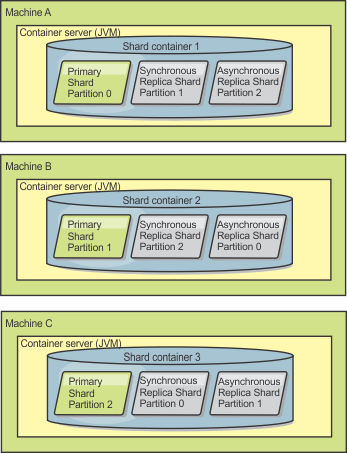Shard placement
The catalog service is responsible for placing shards. Each ObjectGrid has a number of partitions, each of which has a primary shard and an optional set of replica shards. The catalog service allocates the shards by balancing them so that they are evenly distributed over the available container servers. Replica and primary shards for the same partition are never placed on the same container server or the same IP address, unless the configuration is in development mode.
If a new container server starts, then eXtreme Scale retrieves shards from relatively overloaded container servers to the new empty container server. This movement of shards enables horizontal scaling.
Scaling out
Scaling out means that when extra container servers are added to a data grid, eXtreme Scale tries to move existing shards, primaries or replicas, from the old set of container servers to the new set. This movement expands the data grid to take advantage of the processor, network and memory of the newly added container servers. The movement also balances the data grid and tries to ensure that each JVM in the data grid hosts the same amount of data. As the data grid expands, each server hosts a smaller subset of the total grid. eXtreme Scale assumes that data is distributed evenly among the partitions. This expansion enables scaling out.
Scaling in
Scaling in means that if a JVM fails, then eXtreme Scale tries to repair the damage. If the failed JVM had a replica, then eXtreme Scale replaces the lost replica by creating a new replica on a surviving JVM. If the failed JVM had a primary, then eXtreme Scale finds the best replica on the survivors and promotes the replica to be the new primary. eXtreme Scale then replaces the promoted replica with a new replica that is created on the remaining servers. To maintain scalability, eXtreme Scale preserves the replica count for partitions as servers fail.
